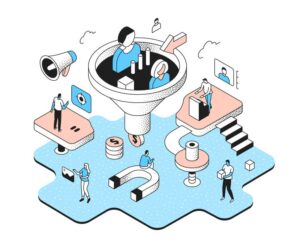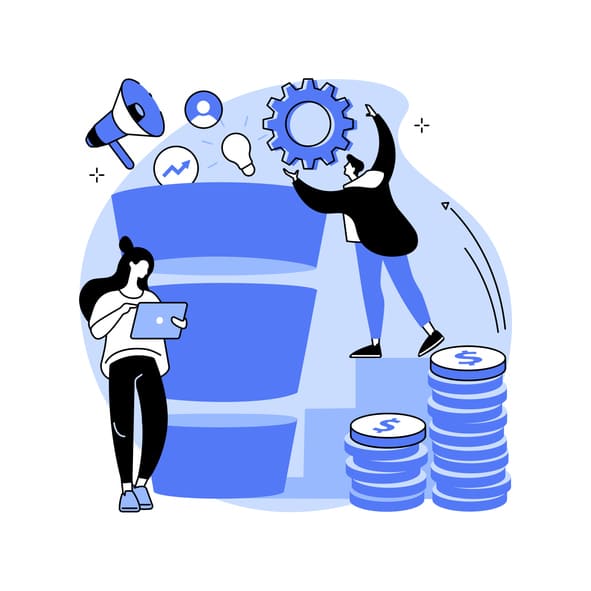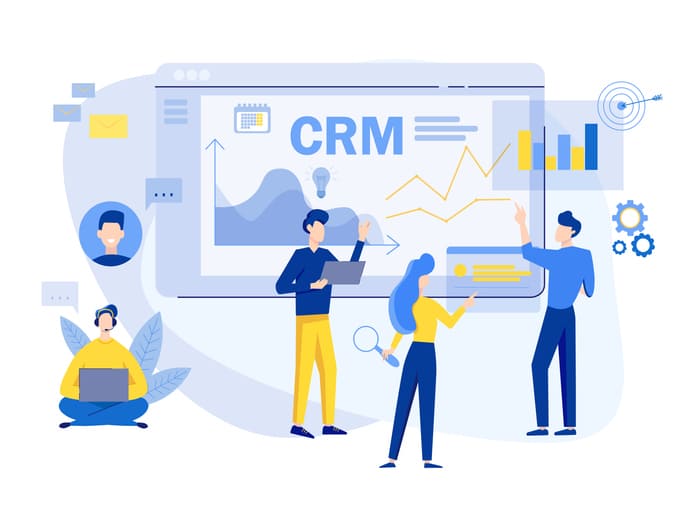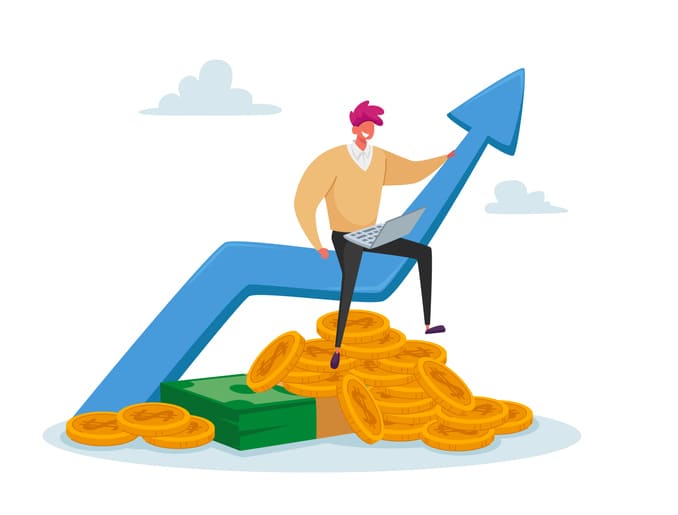What is a Pipeline in Business?
In simple terms, a pipeline in business represents revenue-generating opportunities.
In a B2B sales environment, a pipeline captures and shares each opportunity’s stage, status, and likelihood as they progress towards a close.
The value of monitoring a sales pipeline is that it clarifies revenue generation opportunities in the months and years ahead.
What is a pipeline in business? Think of it as a predictor of the health of a business.

What is a Sales Pipeline?
On a more granular level, a sales pipeline is a snapshot in time of the selling opportunities present for a business.
In some instances, a sales pipeline is also called a customer pipeline, business development pipeline, or client pipeline.
A sales pipeline identifies the various stages in your sales process, also known as a pipeline stage.
To build sales, you need to review the pipeline stages to understand delays, obstacles, or challenges holding the deal back. Therefore, reviewing pipeline stages is also referred to as sales pipeline management or developing a pipeline strategy.
Pipeline creation is the process of developing leads as you start to sell a new product or service.
Let’s review the typical stages in a sales pipeline, managing each stage, and standard sales pipeline metrics.
What’s the Difference? Sales Funnel vs Pipeline
Although the terms sales funnel and sales pipeline are used interchangeably, they are different.
A pipeline captures the stages a buyer progresses through to become a customer. A sales funnel (sometimes referred to as a pipeline funnel) reflects the conversion of prospects that progress through the sales pipeline.
A sales pipeline then is a series of steps and actions a buyer takes, whereas a sales funnel quantifies the number of buyers and the likelihood of their conversion.
 If you were completing a pipeline review, you’d outline the stages your buyers progress through during a typical sale. You’d then quantify the buyers you currently have at each stage of the pipeline and the specific challenges to moving them forward (where applicable).
If you were completing a pipeline review, you’d outline the stages your buyers progress through during a typical sale. You’d then quantify the buyers you currently have at each stage of the pipeline and the specific challenges to moving them forward (where applicable).
A sales funnel report would include those buyers who have converted to a customer.
Benefits of Sales Pipeline Management
Think of a sales pipeline as a visual sales tool. It can depict where each buyer is as they progress through the various sales stages.
Monitoring and managing your sales pipeline is crucial to your success in sales. It lets you keep a close eye on how your buyers progress towards the deal and any areas you need to apply more effort or time.
Fundamentally, sales result from activity. Therefore, the more actions you take to progress your buyers through your pipeline, the greater your likelihood of making a sale and the more sales you’ll make.
 The benefits of being clear on your sales pipeline include the following:
The benefits of being clear on your sales pipeline include the following:
Predicted Revenue
A clear pipeline can provide insights into the opportunity to close sales and, therefore, allow for revenue prediction.
Sales Performance
Ensure you are focused on the right activities at the right time, increasing your awareness of any gaps or problems with your pipeline.
Allocate Resources
Gaps in your sales pipeline can identify opportunities to allocate more resources or tap into the expertise, whether you need to hire more salespeople or bring in subject matter experts to assist in overcoming objections.
Bottlenecks or Constraints
If you have internal blockages such as generating quotes quickly or responding to buyer inquiries, your sales pipeline will highlight where these constraints exist, allowing you to focus on resolution.
You can monitor gaps in your sales activities by using a Customer Relationship Management (CRM) pipeline report or developing your pipeline tracking method. Assessing gaps in your sales activities is sometimes referred to as pipeline analysis or pipeline development.
Let’s look at a couple of sales pipeline assessments.
If you have few qualified leads, as an example, it suggests your prospecting isn’t effective, or you’re time prospecting is spent with those who aren’t your ideal buyer.
Alternatively, if your sales meetings are infrequent, it can highlight that you aren’t qualifying buyers fast enough.
7 Sales Pipeline Stages (+ Other Pipeline Essentials)
 If I asked you to share your sales pipeline with me, you’d typically walk me through how many sales deals you’re working on, the next steps in each deal, where you might be stuck, what the next steps are, etc.
If I asked you to share your sales pipeline with me, you’d typically walk me through how many sales deals you’re working on, the next steps in each deal, where you might be stuck, what the next steps are, etc.
There are several stages in a sales pipeline, which can differ depending on what you sell, and the market you serve. Each stage identifies a critical step in moving a buyer from interest to the sale.
If you build a sales pipeline or want to improve your existing pipeline, consider the most common stages below and set clear targets for each that align with your historical sales performance.
The most common sales pipeline stages include the following, although they can differ depending on what you are selling and to whom:
1. Prospect
This is the stage at which a buyer enters your sales pipeline, often captured by marketing through a variety of lead generation activities.
2. Qualify
This is the pipeline stage at which you confirm that your buyer has needs that your product or service can satisfy. In the simplest of terms, the qualifying stage includes ensuring the following:
- You are speaking with someone who can buy from you.
- That person needs what you are selling (existing or future).
- They have a budget that will support buying your product or service.
3. Present
Also referred to as a “demo,” the buyer is educated on the features and benefits of your product or service. Buyers at the presentation stage of your pipeline have a series of discussions or a more formal presentation using PowerPoint or other marketing materials.
You often encounter questions and objections during this stage that can stall the sale or move it forward.
4. Proposal
You have provided your buyer with a quote or proposal at this stage of your pipeline. Typically this includes basic details about your product or service, including a description, specifications, pricing, terms, etc.
The goal during the proposal stage is to ensure that anyone you’ve provided a quote or proposal to is interested in buying what you sell. Providing a proposal to someone not yet interested serves to increase your proposal rejection rate.
5. Negotiation
In this stage, you engage in dialogue with your buyer to ensure the proposal is aligned with their expectations and addresses any questions, concerns, or objections they bring forward.
6. Close
During the close stage of the pipeline, the buyer has received your proposal or quote, and you are attempting to confirm (or close) the sale.
The close stage typically involves several steps that can include:
- Ensuring you have a precise date, time, and action for a follow-up discussion.
- A method of follow-up that ensures you remain in touch with your buyer.
- Willingness to continue following up with various approaches to moving the sale to a close.
- An ability to flush out, deal with and overcome objections.
- Support from your manager or other internal experts to help address questions or objections.
7. Post Sale Support
This can include in-depth demonstrations, trials, introducing the buyer to additional team members, and other support to help them begin using your product or service.
Sales Pipeline Management
What is pipeline management in business?
It refers to the process of monitoring each stage of your pipeline closely, monitoring for any gaps, inconsistencies, or problems so that you can keep deals (and sales) flowing.
Sales pipeline management best practices begin with being clear on the key performance indicators (KPIs) that identify the health of your sales pipeline.
 The most common sales KPIs include the following:
The most common sales KPIs include the following:
Number of Leads
How many leads are you currently in discussions with? The more focused we are on outreach activities, the better our chances of finding and generating leads.
Quality of Leads
Having leads is good, but ensuring they are the right leads is better. Are you speaking to the decision-maker? Focusing on connecting with your ideal buyer is essential. The harder you work to ensure you’re talking to the right people, the greater your likelihood of converting a lead to a deal.
Deal Size
Identifying the approximate size of the deal is vital to help determine how much time you should invest in moving the sale forward. A small deal size suggests an opportunity to focus time elsewhere on bigger deals.
Probability of Close
This identifies the likelihood that a deal will close and is a crucial predictor of the revenue generated from the current pipeline leads and sales.
Armed with intelligence about how full or empty your sales pipeline is including bottlenecks or obstacles that exist, you can begin pipeline forecasting to determine if you’ll achieve sales targets.
To forecast sales opportunities, you’ll need to incorporate several tools to help automate some data management and allow easy reporting on your sales pipeline.
The most common tools that can assist in managing a sales pipeline include the following:
- Use a Customer Relationship Management (CRM) system to track buyers at each stage of your pipeline. An example of a CRM software is salesforce; however, there are dozens of other options depending on your needs.
- Introducing software like Databox for tracking sales pipeline key performance indicators is a great way to stay on top of progress and activities on all pipeline stages.
- Investing in sales training your team is an excellent way to ensure they are effective in each area of the sales pipeline. From handling objections to presenting, it’s a quick means to improve sales pipeline performance.
Check out these great options if you are looking for more software to automate and enable your sales pipeline.
Pipeline Review: Sales Pipelines Keep Sales Flowing
It isn’t easy to sell if you don’t understand your sales pipeline.
Fortunately, a pipeline isn’t challenging to create or manage when using the steps and metrics outlined above.
The information and insights gained from keeping a close eye on your sales pipeline will help to focus your efforts and energy where they can have the most significant impact on your sales and business success.
What steps will you take to improve your sales pipeline?
© Shawn Casemore 2022. All Rights Reserved.


Share This Article
Choose Your Platform: Facebook Twitter Google Plus Linkedin